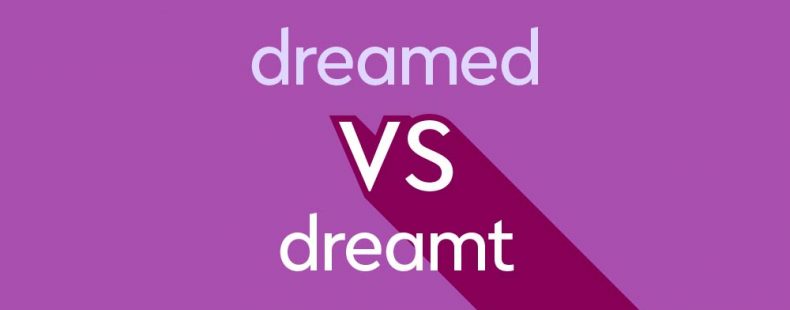We all dream—both literally and figuratively. So which word should we use when referring to dreaming that happened or started in the past?
In this article, we’ll answer any question you can dream up about the difference between dreamed and dreamt.
⚡ Quick summary
Both dreamed and dreamt are correct forms of the past tense and past participle of the verb dream. They are both commonly used.
Is it dreamed or dreamt?
Both dreamed and dreamt can be used as the past tense and past participle forms of the verb dream (in both its literal and figurative senses). Both forms are used interchangeably.
Here are two examples of dreamed and dreamt being used in the past tense:
- Last night, I dreamed/dreamt about a unicorn.
- When I was young, I dreamed/dreamt of becoming a musician.
A past participle form of a verb can be used to form the present perfect verb tense (have dreamed/dreamt) or the past perfect verb tense (had dreamed/dreamt).
Here’s an example of dreamed and dreamt being used in present perfect form: I dreamed/dreamt of this moment!
And here’s an example in past participle form: I had dreamed/dreamt that I would become a musician, and then it happened.
Is dreamt regular or irregular?
The past tense and past participle of most verbs are formed by adding -ed or -d to the end of the root form of the verb—as is done when forming dreamed from dream. Verbs whose past and past participles follow this general rule are called regular verbs, whereas verbs that don’t act this way are called irregular verbs.
Learn more about irregular verbs with our comprehensive guide.
Though dreamt is sometimes considered to be an irregular form, adding -t to form the past tense or past participle follows the same pattern as adding -ed—without the more drastic spelling changes seen in irregular verbs, such as when catch changes to caught.
But dreamt isn’t the only verb that ends this way.
Examples of –t in past tense and past participle forms
The use of -t when forming past tense or past participle is thought to be influenced in part by speech patterns (meaning that, in some cases, the dominant form likely emerges simply because it’s easier to say).
Some verbs that add a -t instead of -ed or -d add it directly to the end of the word without any other spelling change.
Examples: dream becomes dreamt; learn becomes learnt
Sometimes, though, the spelling and vowel sound in the middle of the word can change along with the ending.
Examples: feel becomes felt; sleep becomes slept
Some verbs only use the -t form in their past and past participle forms.
Examples: creep becomes crept; sleep becomes slept; weep becomes wept; keep becomes kept
Note that some -ed forms, such as sleeped and keeped, are never used and are considered incorrect.
In other cases, both the -ed and -t forms of a verb are used.
Examples: dreamed and dreamt; burned and burnt; learned and learnt; kneeled and knelt; smelled and smelt
Sometimes, both forms are used with relatively similar frequency, as in the case of dreamed and dreamt. In other cases, one of the two forms may be much less commonly used than the other. For example, kneeled is much less commonly used than knelt, and learnt is much less commonly used than learned (particularly in American English).
Check how much you have learned with our quiz
Now that you’ve woken up your memory to learn how and when dreamed and dreamt are used, take our quiz on these two forms of the past tense of dream. You may surprise yourself with what you’ve learned!














